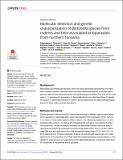| dc.description.abstract | Background
Bartonellae are intracellular bacteria, which can cause persistent bacteraemia in humans
and a variety of animals. Several rodent-associated Bartonella species are human pathogens but data on their global distribution and epidemiology are limited. The aims of the study
were to: 1) determine the prevalence of Bartonella infection in rodents and fleas; 2) identify
risk factors for Bartonella infection in rodents; and 3) characterize the Bartonella genotypes
present in these rodent and flea populations.
Methods and results
Spleen samples collected from 381 rodents representing six different species were tested
for the presence of Bartonella DNA, which was detected in 57 individuals (15.0%; 95% CI
11.3–18.5), of three rodent species (Rattus rattus n = 54, Mastomys natalensis n = 2 and
Paraxerus flavovottis n = 1) using a qPCR targeting the ssrA gene. Considering R. rattus
individuals only, risk factor analysis indicated that Bartonella infection was more likely in
reproductively mature as compared to immature individuals (OR = 3.42, p <0.001). Bartonella DNA was also detected in 53 of 193 Xenopsylla cheopis fleas (27.5%: 95% CI 21.3–
34.3) collected from R.rattus individuals. Analysis of ssrA and gltA sequences from rodent
spleens and ssrA sequences from fleas identified multiple genotypes closely related (� 97%
similar) to several known or suspected zoonotic Bartonella species, including B. tribocorum,
B. rochalimae, B. elizabethae and B. quintana.
Conclusions
The ssrA and gltA sequences obtained from rodent spleens and ssrA sequences obtained
from fleas reveal the presence of a diverse set of Bartonella genotypes and increase our
understanding of the bartonellae present in Tanzanian. Further studies are needed to fully
characterise the prevalence, genotypes and diversity of Bartonella in different host populations and their potential impacts on human health. | en_US |

